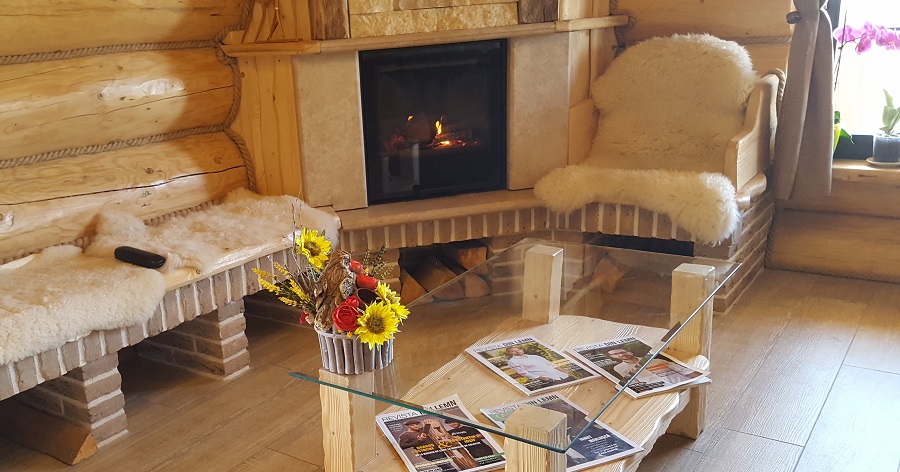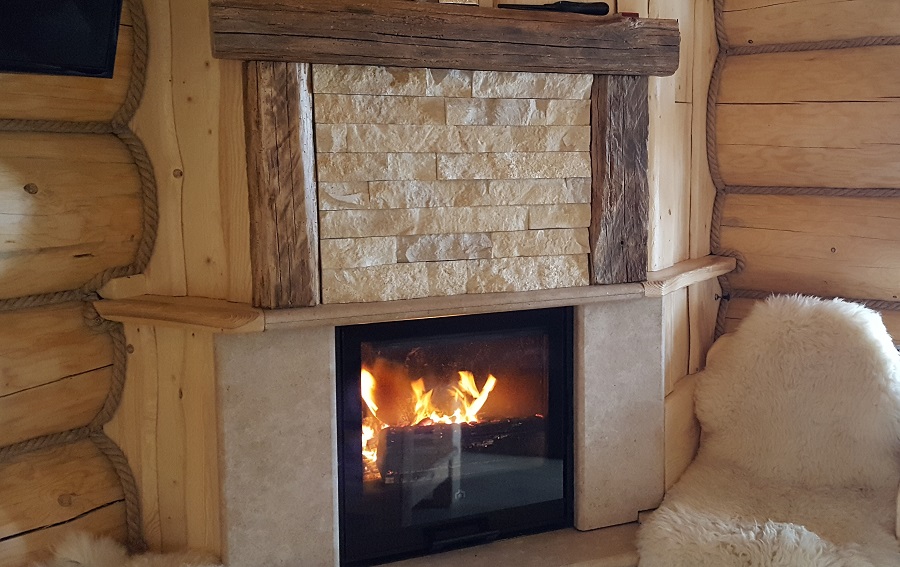Speaking of furniture of all kinds, houses in bușteni or on wooden structure, wooden table tops and epoxy resin, floors, floors, doors, windows and so on and so forth, we have forgotten one of the oldest uses of wood, that of firewood. Until a while ago, burning wood in stoves, in ovens or under pyrotechnics was the norm. My grandmother on my father's side of the family never cooked with anything other than wood. Although most people in the village had switched to cooking on the stove, grandfather didn't like the taste of food cooked that way. So grandmother cooked the food on a pyrostove in front of the stove over a wood fire. The taste was really unique. Our great joy, the grandchildren's great joy, was to go through the pots. By the time we finished eating, we were all dirty with soot from the pots, but who cares!
Back to the combustible properties of wood. Do all species burn the same? If the wood is so different from species to species and even within the same tree, is the heat the same regardless of which wood is burning? Why does the fire sometimes take a long time to start and smoke comes out? At what temperature does the firewood ignite? How do I burn wood efficiently? I'm sure many of you have asked yourself these questions and many more, as have I. I think there are much better ways to use wood than as firewood, but I still appreciate pizza made in a wood-burning oven and a fire crackling in the stove on a winter's day 🙂 .

What is the Calorific Value of Wood?
When wood burns, it produces energy. We feel this energy as the release of heat. The amount of heat that wood gives off through combustion is its calorific value. Calorific value is the amount of heat released when burning 1 kg of firewood. It is measured in kcal/kg, kJ/kg or kWh/kg, with different values depending on the unit of measurement. Calorific value determines how efficiently different types of wood can heat the desired space.
The calorific value is dependent on the moisture content of the wood and is inversely proportional to it. That is, the higher the moisture content of the wood, the lower it is. Green, freshly cut wood gives off less heat than well-dried wood. The maximum calorific value is determined at moisture content 0% (absolute calorific value). As it is almost impossible to achieve this moisture content under normal firewood storage conditions, the moisture content referred to is 15%, which is naturally set by the wood when dried in the environment. It is recommended, however, that the wood be kept indoors near the stove or fireplace for at least 24 hours before being placed on the fire. The humidity will decrease during this time and the wood will burn better and more efficiently.
Calorific value - influenced by wood species and internal wood structure
The calorific value of wood species differs from species to species. It depends on:
- cellulose and lignin content. Lignin has a calorific value of 6000 kcal/kg and cellulose and hemicellulose 4150 kcal/kg. This means that firewood with a higher lignin content (wood resinous) gives off more heat.
- density - The density of firewood is very important. The denser the wood, the higher the calorific value. Hence the differences between the base of the trunk of a tree - denser, higher calorific value - and the top - more loose, burns faster and gives off less heat.
- Cut water content - It is very important to know how much water the wood had at the time of cutting because, after drying, the water leaves voids, resulting in a more loose wood. Wood that has 35-40% moisture when cut (e.g. oak) will be much denser at 15% moisture content than wood that has had a moisture content of 60-65% (e.g. plop, willow).
Despite these differences, there isn't a huge difference in the calorific value of the species when related to mass. Not so much that you would consider one kind of firewood to be useless, whereas another kind of firewood will warm your house immediately. The noticeable difference is in the moisture content, burning rate, surface to volume ratio, which we'll come to in a moment. But first a few examples of calorific values determined at 15% humidity. Not all sources give the same values, but they are fairly close.
- Pine - 4000 kcal/kg
- Molid - 3725 kcal/kg
- Chickpeas - 3700 kcal/kg
- Acacia - 3575 kcal/kg
- Fag - 3550 kcal/kg
- Cherry - 3550 kcal/kg
- Oak - 3450 kcal/kg
- Plop - 3200 kcal/kg
In the above examples, the calorific value of the wood in question is related to its mass. If, however, it is related to the unit volume, dense wood - oak, acacia, beech - will have the higher calorific value.
Wood flammability. Factors influencing burning
Ratio between surface area and volume
Wood burns because it is flammable. To ignite, it needs a fire source. A wood with a medium density and a moisture content of 12-15% ignites at 300ºC. The flammability of wood increases in direct proportion to ratio between surface area and volume. That's why thin wood, sawdust ignites faster than a log. Also in this idea, the suspension of wood dust in the air can be an explosive mixture. Wood burns from the outside in. A thin wood will ignite faster and burn quickly, while a thicker wood will burn longer.
Humidity
Humidity is another factor that influences burning. Wet wood burns more slowly because water has to be removed first. The calorific value of wet wood is lower because some of the energy is used to evaporate the water. It is first released free water and then bound water of the woody structure. The water gradually disappears as the fire moves inward. Removing it quickly creates stresses and the wood cracks, spreading sparks. The denser, harder the wood, the greater the stresses, increasing the likelihood of sparks.
Air circulation
Wood burning is an oxidative process. To be maintained air is needed (especially oxygen in the air). This is why a covered fire goes out and when a source of air comes in, the fire gets hotter (like when you open a door or window in a room where a fire is burning hot). It has been determined that it takes 0.6 kg of air to burn 1 kg of wood. Due to the larger amount of air present in large pots, hardwoods burn better than softwoods, the latter having very thin vessels closed at the ends (tracheids). Wood with large pores burns better than wood with small pores. But the density of the wood also plays a role. The denser the wood, the harder it is to ignite and the slower it burns, giving off heat for longer.
Which species burn more efficiently
Softwoods burn more slowly and release more heat (due to their higher lignin content). Another reason why softwoods give off more heat is their resin content, which is considered to be a real fuel. Young or less dense hardwoods burn faster and give off less heat. As their density increases, they will give off more heat than a similar volume of resinous wood.

Burning wood - for warmth, protection and coloring
Burning wood for heat or cooking is actually combustion, since it is total. I've written about burning wood before, but that was about protection and coloring. For those interested in the Japanese Shou Sugi Ban method of protecting outdoor wood or emphasizing the natural design of wood by burning, find information here.
Total combustion of firewood at maximum efficiency results in water, carbon dioxide and ash. Ash represents between 0.5 and 1% of dry wood volume. If the firewood is too wet and too thick or the air is insufficient (poor draught, the wood has been arranged in such a way that it does not allow air to flow), the combustion is incomplete and dangerous gases (carbon monoxide, nitrogen monoxide) and smoke are produced. Smoke is carbon (charcoal) entrained by air or water vapor before it is completely burned and converted to carbon dioxide.
The heat from burning wood is not dry because water is removed during the process - both the water in the wood and the water from the total burning of the wood mass. Therefore, in rooms with a wood-burning stove or fireplace, the warmth is pleasant and the nostrils do not feel dry.
Wood waste - raw material for combustible materials
It is also possible to use wood as fuel without burning tree trunks, firewood in general. Waste from processing - sawdust, wood dust - can be processed and turned into an energy source. The result is briquettes or pellets used to fuel boilers and heat-producing stoves. Lately, pellets have become a favorite because they are lightweight and 10 times smaller than briquettes and can be pneumatically transported to the burning area.
Both briquettes and pellets are made by pressing waste wood in special devices without the addition of glue. Gluing is due to the moisture content of the wood. Therefore the wood should have a moisture content between 12 and 15%. If it is wetter, it must be dried beforehand, otherwise it will fall apart. Also, for good bonding, there must be no bark in the mixture. Technological processes and installations are different, briquettes being obtained at lower pressure than pellets.
Although it is such a common topic, I hope I have come up with new, useful information for you. If you think it would be of interest to others, feel free to share. If you have any comments, questions or additions, please leave them below in the dedicated space.



































Just an addition - the list of caloric capacities per kilogram given above can be misleading, that's why I think some explanations are useful.
Namely, firewood is not sold by the kilogram but by the pound or cubic meter, which are units of volume, not mass. Even if the heat capacity of softwoods is higher than that of hardwoods in relation to mass, normally, if we take into account the difference in density, hardwoods have a higher heat capacity in relation to volume. A cubic metre of softwood usually weighs less than three quarters as much as a cubic metre of hardwood. This makes it more advantageous to burn hardwoods per cubic metre, except for some soft, less dense hardwood species, such as willow or poplar, in terms of heat release. In fact, the firewood with the highest bulk density of energy available from burning is acacia, even though the mass energy density of acacia is below that of most softwoods. (There is another wood that most likely has an even higher bulk heat density than acacia, although I could find no data on it - hornwood. Except that it's not really used as firewood, and as dense as it is - it sinks in water - I'd expect it to burn extremely hard.)
In other sources I found other values of the lower calorific value
Specific lower calorific value of some types of wood (HUMIDITY 15% !!!)
SALCaM Cca. 6.3 kwh/kg (5,420 kcal/kg)
CARPEN Cca. 5.3 kwh/kg (4,560 kcal/kg) ...
MOLID, BRAD Cca. 4.5 kwh/kg (3,870 kcal/kg)
PIN Cca. 4.4 kwh/kg (3,784 kcal/kg)
ARTAR, MESTEACAN Cca. 4.2 kwh/kg (3,612 kcal/kg)
FAG Cca. 4.1 kwh/kg (3,526 kcal/kg)
STEJAR Cca. 3.7 kwh/kg (3,180 kcal/kg)
PLOP Cca. 3.1 kwh/kg (2,666 kcal/kg)
Do you have data on fig wood? I've been told it's not good for firewood but I can't believe...
Good evening!
According to our information, fig wood can be burned provided the leaves are immediately removed from the branches and it is thoroughly dried. The leaves and sap contain furanocoumarins, toxic substances that irritate the skin to the touch. Being more of a shrub, firewood consists of many thin branches and trunks that may also have leaves. These need to be removed before the wood is allowed to dry. The wood burns quickly and the burning temperature is high. It does not release heat for long periods.
It is also one of the most aromatic woods used for smoking food, quickly giving off a sweet, floral aroma. It is especially used for smoking poultry and seafood. Again, the sap must be completely removed by drying and the wood must be leafless.
I think that the clarification was very useful, both for Iuliana and for those who read the article presented.
[…] https://revistadinlemn.ro/2019/06/27/lemn-de-foc-putere-calorica/ […]
Thanks for the info! very useful!
I would like to know if cylindrical or "brick" type briquettes are suitable for heating with classic terracotta stoves...Thanks.
They can be used in classic terracotta stoves, but the load must be lower, 1/4 max 1/3 of the wood load. Because more ash results, cleaning should be done more often. Several types of wood are used to make briquettes. Therefore there may be more deposits all along the flue gas outlet and the chimney should be inspected and cleaned more often.
Hello,
Please help me with my understanding of a principle/practical aspect described below.
The difference in calorific value between deciduous (hardwood) and softwood (softwood) is relatively close when referring to the mass of the wood under the same moisture conditions (all varying between approx. 3500-4000 kcal/kg), with the result that softwoods still have approx. 10% more calorific value than deciduous.
When it comes to wood density, hardwoods are about 35% heavier than softwoods.
If we consider both of the above aspects, it follows that for the same volume of commercially purchased wood (firewood, let's say we can get it by the net or by the pallet) we will have an energy gain of approx. 25% (35-10) higher for hardwood.
Given that hardwood is on sale for double the price of softwood (I found it for 700 vs 350) my understanding is that it is more convenient to buy softwood for wood heating where I will have a gain if we consider how much money you pay per unit of energy you will get.
Please comment/confirm my understanding.
Thank you.
Hello!
The reasoning is correct. However, the burning rate is also part of the equation. It depends on how long the fire remains in the stove. Dense wood generally burns more slowly, which means that dense wood (beech, for example) burns longer. As a result, more wood will be burned to maintain the same comfort.
In firewood, the moisture content is also very important. If the wood has a high moisture content, some of the heat energy will be consumed in removing water by evaporation.
Indeed, the difference from single to double can tip the balance towards softwood. But you should know what kind of wood it is (softwood or poplar, for example), how wet it is, whether it is young, less dense or mature wood.
All the best!
Dear Madam...
You don't speak Romanian... Right...
Or... Or rather you were not born speaking Romanian... But... Any other language...
Not Romanian anyway...
You wrote like this...
1).... "It has been determined that 0.6 kg of air is needed to burn 1 kg of wood"... ... ... ?????.... Seriously....
You calculate the air...
PER KILOGRAM...??? How stupid...
The rest of us measure the air... IN CUBIC METERS...
2).... "Total combustion, AT MAXIMUM YIELD, results in ash, carbon dioxide and water"...???????
The text belongs to you... But I used the typeface to underline the idiocy of the wording...
So one out of two... Or...
1.... YOU DO NOT SPEAK ROMANIAN
2.... USE MACHINE TRANSLATION
... Because you are LENE to translate yourself...
... Not to mention the burning or COMBUSTION that of... We have modernized and we are ashamed not to use... Anglicanisms...
Wood burning is total... ONLY... In Russian bell stoves... I mean KUZNEZOV Model stove...
In any other stove the burning... IS NOT COMPLETE...
I think it's the weight at different moisture, the density remains constant. "Wood that has 35-40% moisture content when cut (e.g. oak) will be much denser at 15% moisture content than wood that had a moisture content of 60-65% when cut (e.g. poplar, willow)."